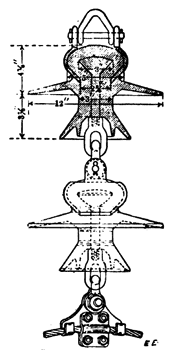[Trade Journal]
Publication: The Electrical Engineer - London
London, England
vol. 42, p. 126, col. 2
FLEXIBLE SUSPENSION INSULATOR.
The accompanying illustration, taken from the Electric Railway Journal, shows a suspension type of high-voltage insulator which is claimed to possess many desirable features. Between the two unite, and between each unit and the structure which it supports, or from which it is suspended, there is provided a universal joint which allows absolute freedom of movement. Thus the insulator as a whole is entirely flexible, and no portion of the dielectric is subjected to unnecessary mechanical stress. However, the units have been designed with special reference to mechanical stresses, it being estimated that a tensional force of 20,000lb. can be withstood. Mechanically considered, the unit is built up of a central bolt ¾ in. in diameter, having a conical head 3 in. in diameter. External to this head, and separated from it by 1 in. thickness of "Electros" insulation, is an outer cylindrical bell, having such dimensions that it cannot part company with the central bolt, even though the insulating material were totally destroyed.
 |
| Suspension Insulator. |
The dimensions given above refer to an insulator having a hood 12 in. in diameter, each unit being capable of withstanding an electrical pressure of from 35 k.v. to 40 k.v., and the insulator as a whole is designed for 60,000-volt circuits. It has been selected for use at this voltage by the Indiana Steel Company. It is interesting to note that each element of this insulator is practically identical with the 12 in. insulators employed exclusively on the Niagara-to-Buffalo transmission line of the Canadian Niagara Power Company, which company recently placed an order for 900 additional insulators of the same type The insulators described are built by the Electrose Manufacturing Company, of Brooklyn, N.Y.
